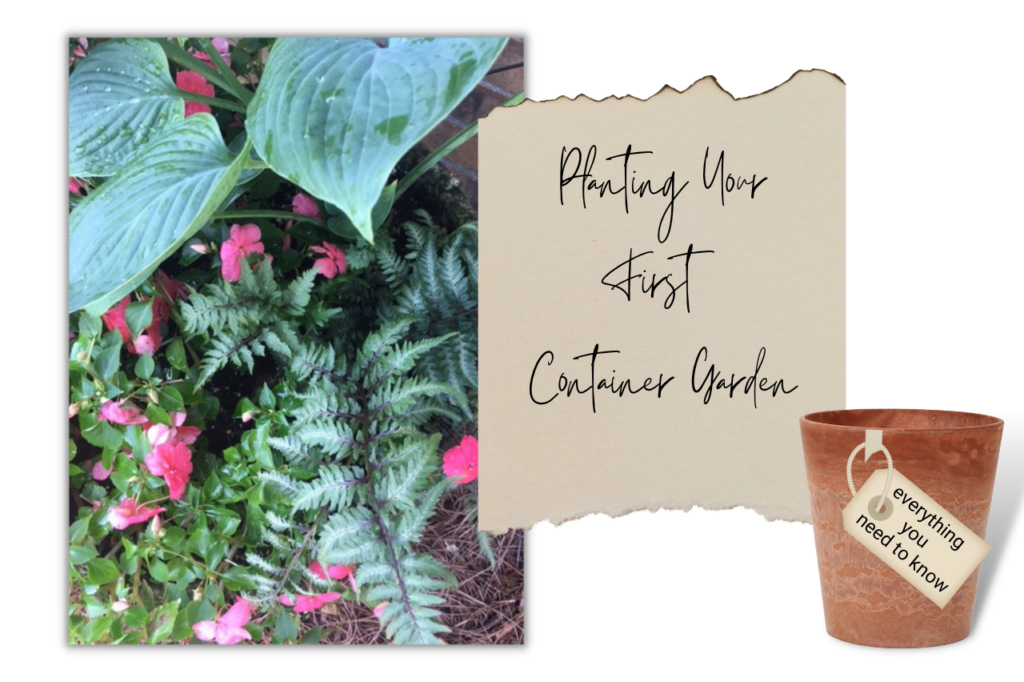July 9, 2021
Thinking about a container garden? A beautiful mix of plants that cuddle peacefully together? Good news: It’s not complicated! Here you’ll find how to select plants to create your own dreamy container garden.
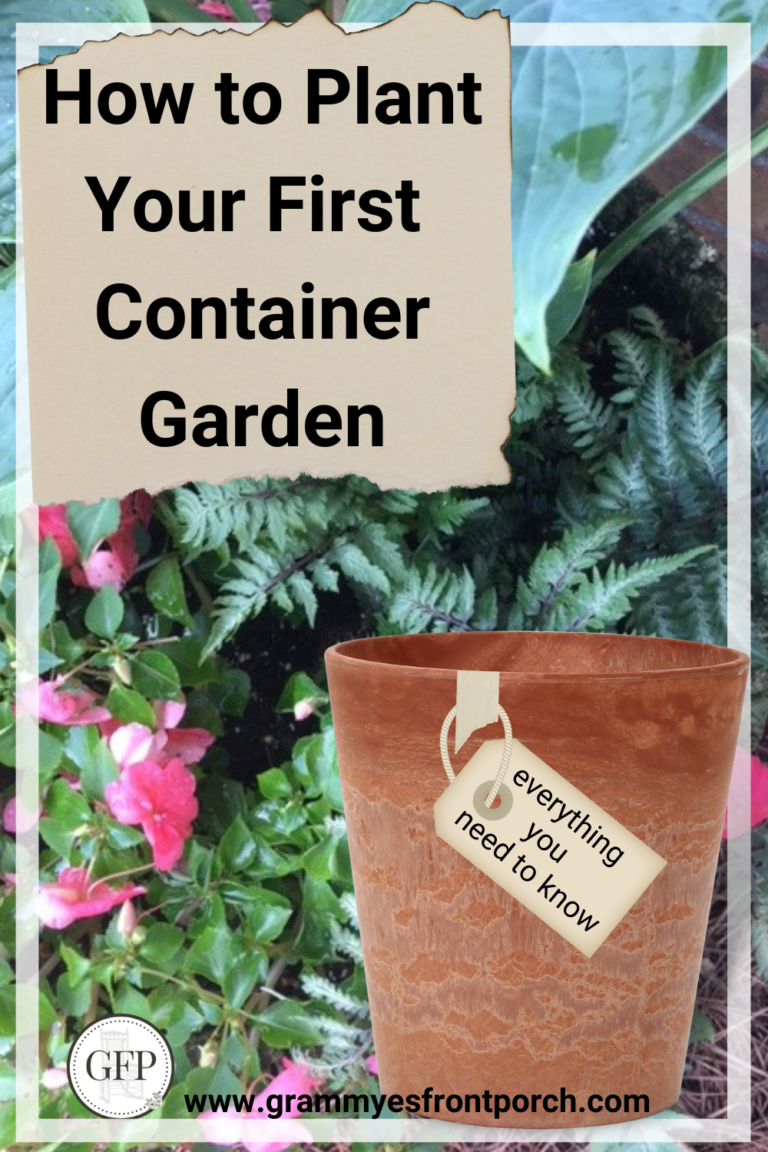
WHAT MAKES ME QUALIFIED TO TELL YOU HOW TO PLANT YOUR FIRST CONTAINER GARDEN?
The truth? Absolutely nothing.
Sometimes I’ve talked about taking care of plants. And I’m learning.
I’m not an expert. Far from it. I have neglected, mangled, and ruined way more plants than anyone I know.
What is the problem? Well a lot of things.
I am not so good with houseplants. No matter what I did, I was always over- or under-watering them. So I moved outdoors with my efforts.
A small victory: I have figured out watering my outdoor plants.
And that wasn’t done independently. Several people really encouraged me, taught me things, and suggested plants. Always the thing, right? To have a conversation with someone smarter?
So it’s time to pass along a little cutting from the gift that grows for everybody: knowledge.
Here’s one thing I learned about watering plants: Let them get dry, but not terribly wilted. If they are dry and drooping, go ahead and do it right away. And water very generously early in the morning. Watering in the afternoon doesn’t seem to work as well.
When it’s really hot and dry, like with no rain, this can be daily. In Georgia, it’s pretty common to water every morning. When it’s not so hot it can be every 2 days. And not necessary at all if it rains frequently. Just be sure they are truly in the rain, not tucked too close to the house to receive it.
The second thing to know about watering container plants: planting things in the ground means their roots can extend pretty far to find moisture. That’s not so with containers. The container itself becomes warm and dry in direct sun. And if there’s no moisture in the container, the plant will suffer.
All that to say the decision to plant in containers is also a commitment to do just a little more maintenance.
I mention this to you because I finally know a few things. Just a few.
If you’re an experienced gardener, by all means stick around for entertainment! I am glad you’re here — leave us some pointers in the comments, please!
But know right up front that this is written for the beginning gardener, the person who “gets talked over” when it comes to gardening. You know what I mean. People won’t really explain things, and they only want to talk to others who have experience. Today no one’s talking over your head, using insider language, or refusing to explain things.
Now that we’ve settled my (lack of) authority on the matter, lets talk!
FIRST, THE BASICS, BEFORE YOU PLANT YOUR CONTAINER GARDEN
Selecting plants for outdoor containers is actually fun.
But if you don’t know some of the basic things, you can be overwhelmed at the garden center, or have a “fail” with your plants.
Let’s start by talking about some of the basic things to know about plants, and what you find at the garden center.
Then, once you know the categories, you can start looking at what you need.
Here are a few pictures of the plants at the store.

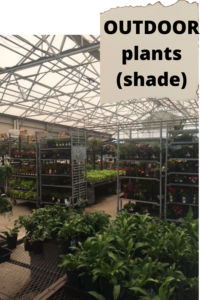
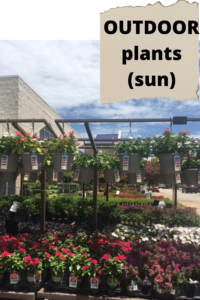
I’m leaving those pictures there for you, along with these plant labels, to help illustrate what you’re about to read!
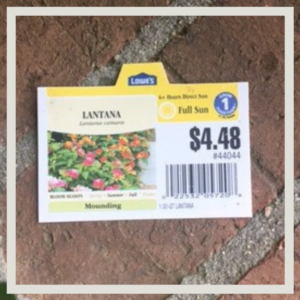



To start with, let’s look at 3 ways plants are categorized.
(If you experienced gardeners are still hanging around, thank you! Someday I’ll be brave enough to venture into more than those three areas — into the subcategories, the exceptions, and the details. For today, this is all we need.)
1. Plants are categorized by indoor and outdoor.
If you’re at Lowes, or even Walmart, there’s a clue. The indoor plants are indoors. And the outdoor plants, well, they are outdoors. Since we’re talking about outdoor container gardens today, we’ll skip any talk about indoor plants.
2. Outdoor plants are categorized by sun lovers and shade lovers.
If you’re at Lowes or Walmart, or any garden center there’s probably another clue. Sometimes a mesh shade covering is over the plants that like to be in the shade. And those plants who love full sun are in (you guessed it) full sun.
Now sometimes you’ll find things where they don’t belong, so just looking at the location doesn’t always give you the answer. I know that ferns like dappled or indirect light, but I often see them out in the blazing sun at the store. Where’s the answer? The labels on the plants will confirm the needs of the plant for you. Some companies even color-code the labels and that really helps.
3. Plants are categorized by annuals and perennials.
Sometimes it’s confusing to hear the terms at first. But I want to help you with that right now, before we get any further. Let’s see if the explanation is helpful and something you can remember.
Annuals are generally plants that survive one year. They don’t survive the winter. They can use up all their energy to produce flowers for a long growing season, because they will not have to live through the winter and bloom again next year. I love annuals, because of the all-summer-long color they provide.
Remember it this way: You will buy them, and you will plant them, and you will enjoy them. They will bloom prolifically, and they will die. And you will buy them again next year. And you will buy them the year after that. Annuals can be a little more work, but if you love constant blooms, you won’t mind having that purchase come up again, and you will buy them annually. (And you will remember this: “andyouwill” sounds a lot like “annual.” 
Perennials have a much shorter bloom season. The rest of the year, through photosynthesis, they are gathering sunlight and preserving their energy for the next year, and the next. The advantage of perennials: you don’t have to replant them every year. As they grow and spread, you can sometimes divide them into separate plants.
Remember it this way: Properly cared for, perennials prevail for plenty of years, probably permanently. People plant perennials for their persistence, their perpetual performance, and their propensity to pretty up the panorama of the property. (Plan to remember this: Perennials can be permanent.)
I hope that short review helps you to remember these two categories.
By the way, a site called Get Busy Gardening has a much more detailed article, Annuals vs. Perennials: What’s the Difference? by Amy Andrychowicz. There you will find more subcategories, exceptions, and helpful explanations. Way more detailed than my brief explanations.
One more really helpful topic that shows plenty of advantages and examples of each is Know Your Plants at My Garden Life. Her pictures are gorgeous.
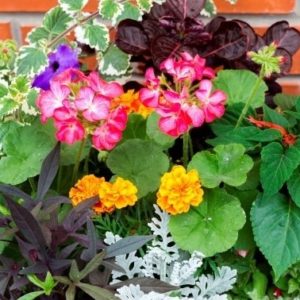
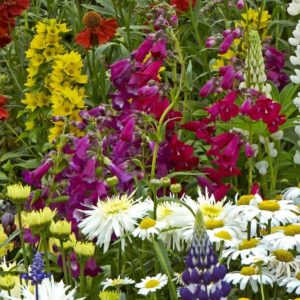
PLANNING AND PLANTING YOUR CONTAINER GARDEN
One thing that will really help you plan everything is to collect a few pictures of things you like. Colors, types of plants, types of containers, etc.. Use Pinterest if you want, to collect your ideas.
I’ll give you the overview of the steps, so you’ll see it’s really something you can manage.
And I will help you “dissect” the plantings you’ve found in those pictures, and see how it’s done.
I promise, it’s not complicated! I’ll even give you a suggested “shopping/supplies list” at the end.
Here’s what you’ll be doing:
- Planning,
- Selecting a container,
- Purchasing your plants and supplies,
- Arranging them in the container.
How To Plant Your First Container Garden: PLANNING
With the above 3 categories we reviewed in mind, you can begin to plan a container garden. Taking just a little time to plan well can make the difference in whether your plants live or die. That sounds dire, doesn’t it! But when you want to plant your first container garden, sometimes your eagerness bypasses making the right selections in the beginning.
The beauty of planning…
I want you to plant a container garden that is beautiful to see, that grows and thrives, and that focuses your heart on the idea of nurture. Even this little bit of gardening enriches your soul and gives you a break from technology.
What you can mix up: Annuals and perennials. That’s fine. Those don’t need to be separated. At the end of the season, the annuals will die and you can remove them. The perennials can usually overwinter — in place, or in a more protected environment while they are dormant.
You can also mix flowering plants with non-flowering plants. It gives you a lot of variety in your container.
What you can not mix: Sun lovers and shade lovers. The plants will all be together, so they will receive the same amount of sun. (Of course we don’t mix indoor and outdoor. But remember: I can’t say that. Because we’re only talking about outdoor.)
Select and observe your location
You’ll be planning a container garden in a certain location. If you’re doing more than one (Yay! I did, too.) then two locations or even more. But it’s perfectly fine to just do one.
Questions you can think about:
- How will I get water to this area?
- How much sun/shade does this receive?
- Will this be easily visible so that I can enjoy it?
Your first easy assignment is this: you should observe the location at different times in the day. And make a few notes.
Because there is really good news: Plants now have a nice detailed label about how much sun they need (or can tolerate). Some even specify a certain number of hours, or morning sun (which is more gentle than afternoon sun).
So keep a watch on your area and you’ll have a good handle on when the sun is there, and how long the area is in direct sunlight.
Make a few quick notes about the area you’re observing. It will help you with your selections.
Don’t let this intimidate you. You’re just figuring out if you need “shade” plants or “sun” plants.
In general, you’ll usually notice more flowering plants in the sun-lovers category, and more subdued colors or non-flowering plants in the shade category. Sun generally produces vibrant color. In fact, I say “more” and “general” because there are plenty of exceptions, with brightly colored cultivars that bloom beautifully in the shade, or non bloomers that can tolerate lots of sun.
SELECTING A CONTAINER
Have you thought about a style? Here are some tips. A whiskey barrel is a great choice for most settings. Terra cotta (clay) pots are easy to find and also great choices for any setting. They may crack over time, especially if they freeze. Glazed pots are less porous and can let roots get soggy, so these may not be a top choice, despite their beauty. A lot of people use them and do just fine, but I have not had the best results. Plastic pots are not always long-lasting, but they are affordable and plenty adequate for a season or two. And they are usually well made.
The bottom line is this: Get a container you like, and see how it works. Just know that it may not last forever. I’ve had some last for many years, both clay and plastic, and some only a season, and it wasn’t totally predictable.
The size should fit the setting. Doesn’t need to be so big you can’t move it around if you need to, and doesn’t need to be so small that your plants don’t fit.
And now, the fun part! Selecting your plants. I’m going to give you the standard formula, which was what “broke the code” for me when I was first learning about this.
But first, check out this feature in Southern Living Magazine: Container Of The Month. Seeing hydrangeas in containers is so interesting to me. They are so beautiful. And I love the mobile garden cart they used. Beautiful plants on top, and all the tools down below. So cute.
Southern Living. Check out their article on Container Gardening if you like. Super ideas for containers, plants, locations.
Showing you this because it just confirms how much help there is out there, once you know what you’re looking for.
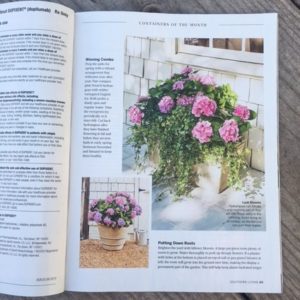

How To Plant Your First Container Garden: PURCHASING YOUR PLANTS
Now, you can begin planning your container. Read through the choices, and then we’ll get down and dirty gathering supplies and creating your masterpiece.
Here’s the easy formula: A thriller, a filler, and a spiller.
It’s not a secret. You’ve probably seen this before.
Container Garden Plant #1: Tall (the thriller)
The thriller is a plant toward the back, or possibly in the center. It’s the tall thing, the anchor that “backs up” everything else. You’re looking for something upright. More tall than wide, more upright than spreading. The label on the plant should suggest the expected height. It can be flowering or not.
Container Garden Plant #2: Wide (the filler)
The filler is different. Something more full, spreading, and dense. It is very visible and fills the space around the first item. This may be called a mounding or cover plant. This is a great place to add a lot of color, but a nonflowering plant is beautiful also.
Container Garden Plant #3: Trailing (the spiller)
The spiller, our last thing, is just what it sounds like. Something softer, that spills over the edge a bit. This completes the picture, softening the line between the edge of the container and the soil inside. It may be referred to as trailing. A vine, flowering or not, is a good example of what you can use here.
This easy formula works for almost every container planting.
Your First Container Garden: Make your own rules!
Guess what? You can cheat if you need to. This formula is meant to be a helpful guide, not a rule. Sometimes the filler and the spiller can be the same kind of plant. And you know what? If you only want one thing in your container, that’s fine, too!
There’s more good news: Though those are the 3 components to create a nice shape with a lot of visual interest, you’re not limited to 3 plants. Have several fillers, several spillers, if you want. Symmetry is not the goal. Allowing all the plants to receive sunlight is important, thus the suggestions for arrangement of the different types of plants.
Container Garden: The colors
Now you’ll select your colors. There’s so much you can do that I won’t even cover that here. It’s your container; plant what you love. Over time I’ve settled on a few colors I pick every year that seem to look nice with the exterior of our house.
Part of the fun is using plants that I know will be happy in the locations I have. It’s also nice to try out something new each year.
I usually pick a non-flowering tall thing (a hosta maybe), a good bunch of flowers in the filler or spiller, and some kind of vine that is low maintenance. Again, pick what makes you happy.
This year I combined hibiscus, lantana, and bacopa. The hibiscus and lantana were very patient about getting their water. But alas, the bacopa was less able to thrive when watering was delayed. (That’s a nice way of saying I killed some of it.)
I also thought it would be pretty to have a hosta, Japanese painted fern, and impatiens. I love those prolific delicate flowers. I still love the look of this container, but the impatiens didn’t “spill” as I expected. To my surprise they grew taller than the hosta and the fern. It’s okay — I still love the look. And there aren’t any container garden police to arrest me. (Are there?)
I’ll show you some pictures in a minute.
Single Plants Instead of Combinations
This article is really about container gardening, combining plants. But if that’s not what you’re planning, or you don’t have time, you can simply place containers of single plants close together for a similar effect.
You still get that nice variety. If that’s your plan, remember this: When you bring home a plant, it needs a slightly bigger container with more soil to grow in. Following the instructions below for planting and fertilizing will still be helpful to you for single plants.
Alternatively, you can place your combinations in the ground and still enjoy a similar effect.
Something that may help as you grow your collection of ideas: When you see a picture of something you are sure you want to purchase, take a picture with your phone. If it includes a description with the name, that’s even better. Then you’ll have your collection of ideas with you at the garden center.
Take a quick look at a little inspiration I found for you — the exciting bloomers in the greenhouse, and the amazing variation in texture and color in the elaborate patio garden.

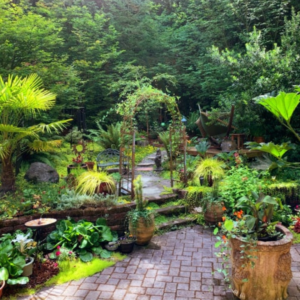
How To Plant Your First Container Garden: ARRANGING YOUR PLANTS IN THE CONTAINER
After all that preamble, now you can purchase your plants and supplies, and arrange your plants in the container.
Let’s review our supplies.
You’ll need a water hose ready to wet things down. Probably a trowel, maybe a little fork/rake type thing, and some kind of cup or dish to dip your potting soil from the bag. I also keep a pair of scissors handy to open bags, cut landscape fabric, etc.. I purchased a small lightweight garden cart this year and it made a huge difference in being able to move things around easily. If you have a small chair or stool, or a rolling garden seat, you’ll be way more comfortable. You’ll be surprised at how much time you spend crouched over this project you’re doing!
(I’ll show you all these things in a few minutes.)
You’ll need some good potting soil.
Use Miracle Grow potting soil, or trust the recommendation of a professional at a garden center. I’ll warn you that some brands do not have very tight quality control, and you may be disappointed in what you find in the bag. It’s easy to make that “less-expensive” choice when you see the price tags, but I think it’s worth it to go with a trusted brand.
If this decision is difficult, it may help to realize that the soil is your plant’s food. If it is already depleted when you purchase it, there will be little nutrition for your plants to use for their health. I’ve strayed from the name brand, and I returned.
If your container is large, you can use a filler in the bottom.
This helps with several things. It keeps the container light in weight, it helps with drainage, and it uses less of that expensive top-quality potting soil you just bought.
Picture the roots of your plants, and giving them plenty of soil to live in. You definitely want it plentiful, but you don’t have to use an excessive amount.
(Things like this can be a little confusing — “So how much dirt?” is your question, right? Try this: look at every plant you are placing in the container. You want to at least double the size of the dirt it’s already planted in. That helped me. You’ll be safe to do that and even better to triple it. So scientific, right?)
What do you use to fill the lower part of the container? Packing peanuts, empty water bottles, broken pieces of old clay pots, things like that. (You know what’s funny? Beginner gardeners don’t have broken pieces of old clay pots. Perhaps we should make that a part of our goal setting.)
I used fillers in the bottom of my whiskey barrel, but none of the other containers were large enough that I needed filler.
I also like to use landscape fabric to line the bottom of the container.
Landscape fabric comes on a roll, like wrapping paper. It is a very handy product –a woven semi-sheer mesh fabric that blocks weeds and allows water to pass through. In a container, it contains the soil but lets water run through. This is helpful if your containers are on a porch, sidewalk, or driveway. You don’t want soil running out with the water from the drain holes.
You know what? If you don’t have landscape fabric, it’s okay. There’s another household item that works: coffee filters. There should be a whole post on uses for these things. They are sturdy enough to layer in the bottom of your container to protect the soil from leaking out the drain holes. And just like landscape fabric, water will drain right through!
IT’S TIME TO GET IT DONE!
Go ahead and place your container where it will be. Or at least close. It’s so much easier to move it around before it’s full. Also, it’s best to do your planting at a shady time, if your container will be in the sun. Have all the supplies we mentioned close around you.
Line the lower part of the inside of the container with landscape fabric. It doesn’t have to be perfect. But you’re trying to cover the drainage holes. That’s all.
Add your filler if needed.
Pour in the soil, but don’t fill the pot just yet. Go up to about 6″ below the top surface. (That’s a rough suggestion. You’ll be adding in plants and more soil a little at a time in a few minutes.)
Now, water all that soil. Stir it up, get it all wet. Why? Well, you want it thoroughly wet, and it’s easier to maneuver it without your plants in it. Use your trowel or gardening fork to really move it around to accept all the water. Wetting it will compact it slightly.
If this is an unexpected instruction, just give it a try. I was very surprised at how much dry soil remained after I had watered a lot. All that stirring around really does help the water reach all the soil. Skip it, and you have dry areas that may be dry the next time you water also. I can’t explain it, I just am happy someone showed me this.
Finally — Your Plants in the Container!
👉🏻 Pay attention to that top level of the soil on your plants you purchased. You don’t put any dirt above that — you’ll be planting each one to the same depth as they were in the nursery container. All the new extra dirt is at the roots, not above the surface.
👉🏻 The general action here is to eliminate any air pockets, to thoroughly wet all the soil, and to have your plants securely placed without packing them in too hard. They need a little room to grow and spread their roots.
👉🏻 As far as how to space them, you have some leeway. My impatiens really grew quickly in the container — I could have planted less, but the fullness is fine with me. Some people really place their plants right together, and some like to give some space in between. This wouldn’t be something to stress about. You can always remove something if it’s way too crowded, or add something if a spot doesn’t fill in the way you expected.
👉🏻 It may be helpful to follow a couple of the links in this topic to see examples of how others placed their plants.
👉🏻 You’ll be working your way around the entire container putting your plants in one at a time. It’s easiest to start at the back and work your way forward.
👉🏻 The final soil level will need to be about two inches below the rim of your container. This is to keep dirt from spilling out over the edge later when the plants are being watered.
The first plant:
Take your tallest plant, the thriller, from its nursery container. Just tip it upside down, gently grasp the base of the stem above the soil, and give the container a squeeze and a wiggle with your other hand. Just ease the plant out slowly, take your time, trying to disturb it as little as possible. Now loosen the roots gently. Don’t be nervous about this. Sometimes the roots are packed and restricted, and just loosening them up tells them they can now spread out and grow.
Dig a little hole in your moist soil, and place your plant into its position toward the back, and pile in a little more soil right around it. Wiggle it in place, and try to end up with top of the soil about 2 inches below the container rim.
The second plant:
Next, add your spreading plant, the filler. You may have several small plants to place evenly around. Remove them from their nursery containers, loosen the roots gently, and place them, then lightly pack your potting soil to secure them in place.
The third plant:
Last, add your spiller around the edge, and fill in the remaining areas with dirt.
Now, another gentle watering to moisten all that soil you’ve added around your plants.
Now, stand back and admire your work! In about two weeks, there will be a significant amount of growth. Things will be fuller, closer together, and brighter.
How To Plant Your First Container Garden: KEEPING PLANTS HEALTHY
Water often, when the soil is dry. That’s the main idea.
If your soil is moist and the plants are happy, skip it. Watering is a thing beginner gardeners have questions about. I sure did. Here are some helpful bits of advice I received:
- Stick your finger down in the dirt. If you find moisture about an inch down, the plant is probably fine.
- Place your hand flat on the dirt to feel the amount of moisture. If sitting in that spot would get your pants moist, it has enough water.
And when I water, I drench. I want water running out of the drain holes at the bottom. Now, if you water really fast and hard, that happens quickly but you may not have watered all the dirt. So that’s a little deceiving. A medium spray (like rain) over a few extra minutes will have a better chance of wetting the entire container before escaping from the drain holes.
Plan to fertilize once each month. It’s so easy.
Get some Miracle Grow fertilizer, the tub of blue crystals that you mix with water. Buy this when you get your plants in the Spring.
Once you get your new plants in soil, plan to fertilize the first of each month, May through September, or whatever your growing season is. You can do it more often, but once a month will really help.
Here’s how to use the Miracle Grow: I go ahead and water my plants, but not a full drenching like my usual watering.
Then mix up the granules with water, about a gallon for every two containers, or more if you need it
Then wait a little while, then water all your plants again with the fertilizer mixture. You can pour it over the leaves and flowers and into the dirt. It absorbs all of it, both through roots and leaves. Just eyeball what you’ve mixed and divide it among your plants.
Sometimes the response to fertilizer application is right away — perkier plants, better color, more blooms. That’s pretty satisfying for someone who could kill a plant just by standing close to it. (Does that make me a former herbicidal maniac?) Long term you’ll see a healthier plant overall.
Wow! High (dirty-garden-gloved) five! We did it! Thank you for planting with me.
Having said “stand up” a minute ago, I am reminded that often I can’t do that after a long time bending over a plant. Like really, I can’t stand up! I’m all bent over and I feel stuck! It takes a while to get upright again. It’s crazy, because I don’t have any back problems. But now I’ve learned to stand up frequently during this task, move around, change positions. Makes all the difference. So get a small chair or stool, or a seat made for that and make sure you are sometimes standing, sometimes bending, sometimes squatting, sometimes sitting.
More helpful information, and beautiful ideas
If this topic wasn’t quite enough, I have something you will love: 24 Stunning Container Garden Ideas from apieceofrainbow.com. You’ve been warned: It is definitely stunning. You’ll see some of the basic info you read here, plus so much more.
Additionally, there’s a very helpful basic topic from Better Homes and Gardens, 6 great tips for container gardens. Lots of instructions, suggestions, examples. You’ll love it.
Hope you have something pretty to show this Summer.
I’m sharing a few pictures of my combinations below, and the containers they are in. A few are in the ground — most of the ferns, because they come back every year and they are very forgiving.
Sadly my little efforts are not nearly as breathtaking as the 24 stunning examples I just mentioned. Still, many are stunned that I have been able to learn to keep some plants alive!
Something nice: it’s very satisfying to see the growth and the bright foliage. It’s amazing what this does for curb appeal.

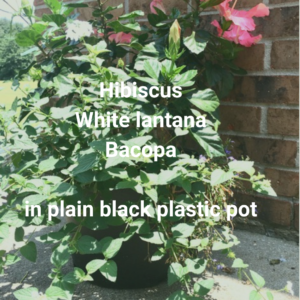
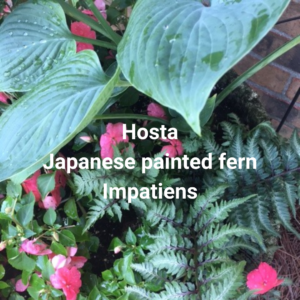
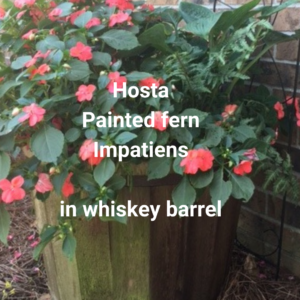
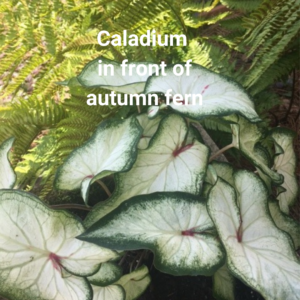
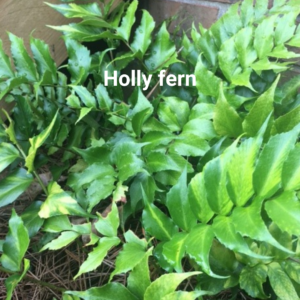
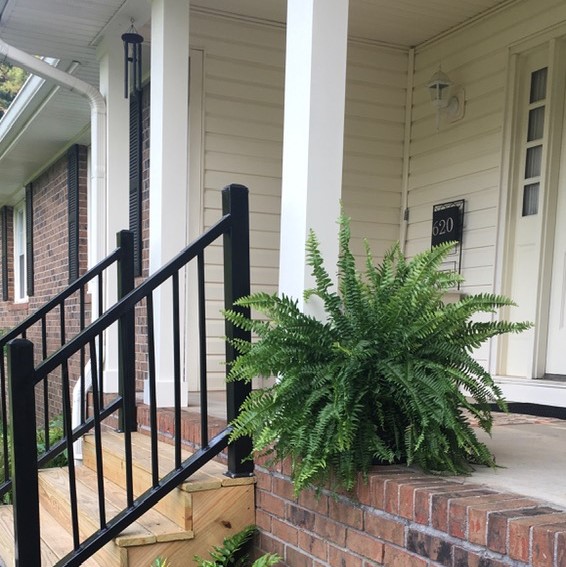


A friend introduced me to ferns as foundation plants a few years ago. Although they are “forest weeds,” certain varieties are extremely attractive. Also, they are easy to maintain, and really hardy.
Autumn ferns, Painted ferns, so many varieties.
And Boston ferns. They’re so… showy! If you get excited about those, check out this article by Megan Stokes, How To Get Big Healthy Ferns. Her Boston ferns are massive, healthy, all that. Everything she said helped me care for my ferns so much better.
I hope this was helpful to you, whether you’re a total newbie or just needed some fresh ideas.
You know what inspired me to create my first container garden? Going to a free seminar. In that short time, I was given SO much information that helped me.
If you have access to something like that, through your local county extension service or through a garden center, do it! Go and find out something you didn’t know before. Mingle with other planters and find out what they struggle with.
UPDATE
I need to brush up on a few more things, friends. First on the list: Deer-resistant plants.
Check out these before-and-after pictures.
Those pretty impatiens before and after my nocturnal visitor.
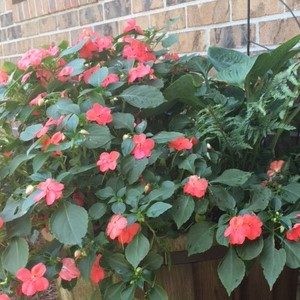
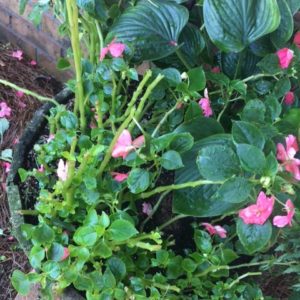
Next, the caladiums, before and after the same visitor.

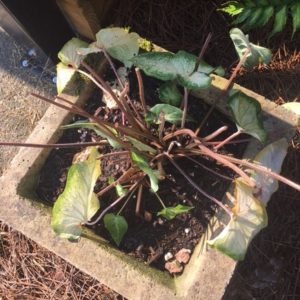
This had to happen, having a deer eat my flowers after the one time I tried to tell everyone how to do it!
Talk about humbling.
(I did not actually see any of this happen, just discovered it one morning.)
We have plenty of woods around our house, so I probably should have seen it coming.
What I didn’t anticipate was the final insult. With all those acres around us, my flower bed was the spot chosen to leave a deposit.
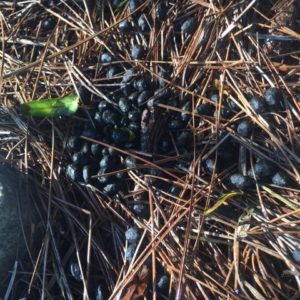
Go for it! The down and dirty of gardening. Who knows what this will lead to?
(It’s obvious I don’t!)
The lantana has LOVED weather over 90 degrees. It’s huge. The caladiums are trying to regrow. No matter what happens, I’ve loved learning and growing. I hope you’ll try something!
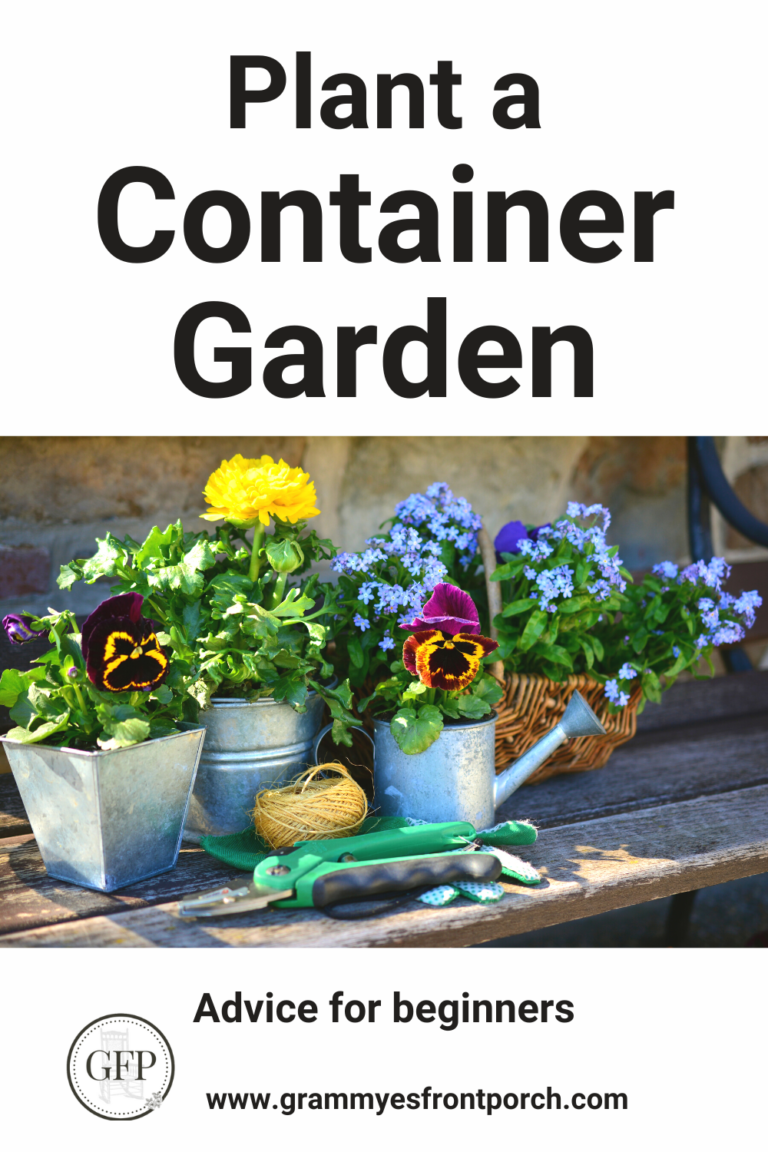
Below is a group of items I’ve mentioned above, things that can make yard work easier, and products that are good for your plants.
And it’s just a start.
One great thing about gardening is this: People love to help you! There’s online help, garden center help, and (maybe the best kind) friend help.
Thank you for visiting! At GFP company is always welcome!
If you liked this topic 🤗, feel free to 👉 share 👈 on Facebook or Pinterest, or send a link to a friend.
Are you on Pinterest? That is a crazy fun place! You can find so many helpful things. Take a look at what I’ve saved for you! A lot of things that never make it to the blog. Here are my Pinterest pins, and I also have categories/boards if you’re looking for something specific.
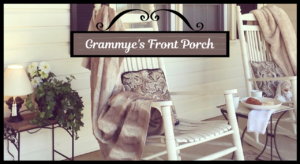
-Grammye
I’m Grammye, and I’m collecting and sharing ideas that can help you embrace the life you have.
When things are difficult, come here to refresh and relax. We’ll have coffee and talk.
You’re invited
to the neighborhood of GFP.
Accept by signing up
and I’ll send you a letter right away.
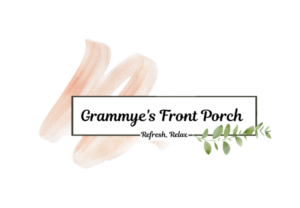
What’s the tip of the week?
Go outside.
Spending time outdoors seems to be diminished for most people these days. We’re tied to screens and devices inside.
Just nudge yourself outdoors more often, to indulge in your surroundings. It is truly therapeutic.
You may be surprised at the relaxation you can achieve, the appeals to your senses, and the increased awareness of creation around you.
Let me know how your planting project comes along. And if you’re watching someone else struggle, do them a favor: send this article or one of the links here. They will love you for that.
This post may contain affiliate links. That’s a good thing. It means if you purchase a product I’ve highlighted, the seller may compensate me for that promotion. I love to share products that are a good value and make life easier. Those little commissions may add up, and can help to offset the cost of running the blog. Or maybe even create a little income. Click here to learn more about this.
